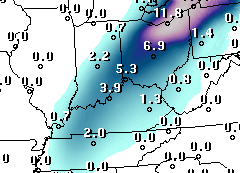Tuesday, January 16, 2018 3 P.M.
The relatively small weather system that moved ever so slowly over southern IN and KY yesterday was amazing to watch. It just didn’t want to move in spite of the models efforts to move it away last evening. Watching the snow pattern move across the radar screen last night was like watching the proverbial paint dry. In spite of the prolonged period of snow, the system still couldn’t generate much snow, but it was an amazing effort.
The last very cold surge (for at least two weeks) of Arctic air has arrived and will dominate our weather for the next two days. We’re seeing a good example of the power of the sun this afternoon. The air temperature is only in the mid teens but yet we’re getting a lot of melting on asphalt roads. Concrete roads don’t absorb as much heat, so they haven’t melted as much snow.
By all large scale features, we should be having temperatures at zero or below tonight. The coldest part of the cold air mass will be over us tonight, we have a snow cover, clear skies and light winds. That normally would produce temperatures in the 0 to -10 range. However, model and human forecasts are predicting a low range of 5 to 10 degrees. Why? Lake Effect
We normally think of snow when Lake Effect is mentioned. Not this time. This is more subtle. The model suite is in agreement that low level winds (3,000 to 8,000 feet) will develop a fetch (flow pattern) from Lake Michigan SSE across IN and into the eastern half of KY. It’s too weak to produce snow, but it should be able to produce mostly cloudy skies after midnight. The clouds trap what little heat we have so our temperatures stay higher. (Skies should remain mostly clear 30-40 miles west of Louisville, so sub zero temperatures are likely there.)
The ability of today’s weather forecast models to pick up on such small details as a Lake Effect’s ability to alter our weather (hundreds of miles away) is really amazing. We’re light years ahead of the two primitive models I started using more than 50 years ago.

